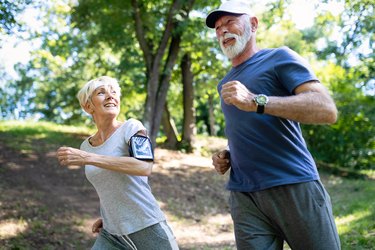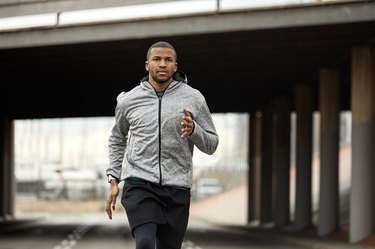
Running is a fairly natural movement, but that doesn't mean it's always easy. Though you likely started running soon after you mastered walking, running for exercise is bit more complicated, especially when you start to consider the right training schedule, clothes, shoes, music and more.
But it doesn't have to be that hard. Once you break down the sport into the essentials — how far to run, how long to recover and what to do for cross-training — it's actually one of the most effective (not to mention efficient) ways to get moving. Here's everything you need to know to start (and stay) running.
What's So Great About Running, Anyway?

You've undoubtedly heard of the endorphin rush that's famously known as the "runner's high," but the mental and physical health benefits of running go far beyond those feel-good chemicals.
Running can help boost your brain health, ease anxiety, lower your risk of dying from heart disease and more —and not just because your coworker or cousin or a runner on the street says so. We dug up the science to back up all those claims.
These are just a few reasons to go for a run.
How to Get Started

Don't be intimidated by those marathoners you see pounding the pavement mile after mile or Olympic sprinters who seem to go faster than lightning. Every runner was once in your shoes when they first started out.
Genetic predisposition to run like Speedy Gonzalez aside, the two main differences between a newbie and a veteran runner are practice and knowledge. You'll have to put in the work for that first part yourself, but we can help you on the second: Learn how to set a goal, pick a training plan and avoid injuries.
Consider this your 101 course for new runners.
Running to Lose Weight

Running has a reputation as being a tried-and-true workout for weight loss. And for good reason: It's an easily accessible, inexpensive way to burn a lot of calories. But there's more to the story than that.
Long-lasting weight loss is the result of a balanced, calorie-reduced diet paired with a workout routine that includes strength training and cardio. So yes, running can be part of that equation; any run that boosts your heart rate for an extended period of time can burn calories and help you lose weight. It's mostly a matter of finding what you'll stick with so you can develop the consistency to reach your long-term weight-loss goals.
Get the full picture of how running factors into your weight-loss plan.
Running Gear Worth the Money

Technically, you don't need any special gear or gadget to go for a run. But if there's ever been a group of people who obsessively tinker with the latest equipment, it's runners. The market is saturated with running gear — from shoes and socks to trackers and armbands.
To avoid getting sucked in by the hype only to have your new purchases sit in the corner collecting dust, ask yourself on your next run, "What would make this more enjoyable? And what would I actually use consistently?" If the answer is nothing, you're set. If not, check out our expert-approved recommendations.
We'll help you gear up with this running equipment you'll actually use.
Cross-Training to Improve Your Runs

Maybe you've been told running is hands-down the best exercise you can do. (Did a runner tell you that?) Whether or not that's true depends largely on your personal preferences, but it's also true that running shouldn't be your only exercise.
Cross-training means regularly dedicating one to two days of your fitness schedule to non-running workouts. That can be a different form of cardio, such as swimming or cycling, or a strength-training session, such as weightlifting or body-weight exercises.
Prevent injury and burnout with these cross-training workouts for runners.
Types of Running Workouts, Explained

Sure, you can just go out there and run, especially if you're simply in it for the endorphins. But if you're looking to improve your pace or train for a race, you need to be a little more strategic than that.
Along with cross-training, it's important to switch up the types of runs you go on. Intervals will help you improve your aerobic capacity and ultimately, your pace. And hills can prepare you for a race course that isn't flat the whole way. Even people new to the sport can try running workouts designed for beginners.
If you can't tell your Fartlek from your tempo run, read up on running workouts.